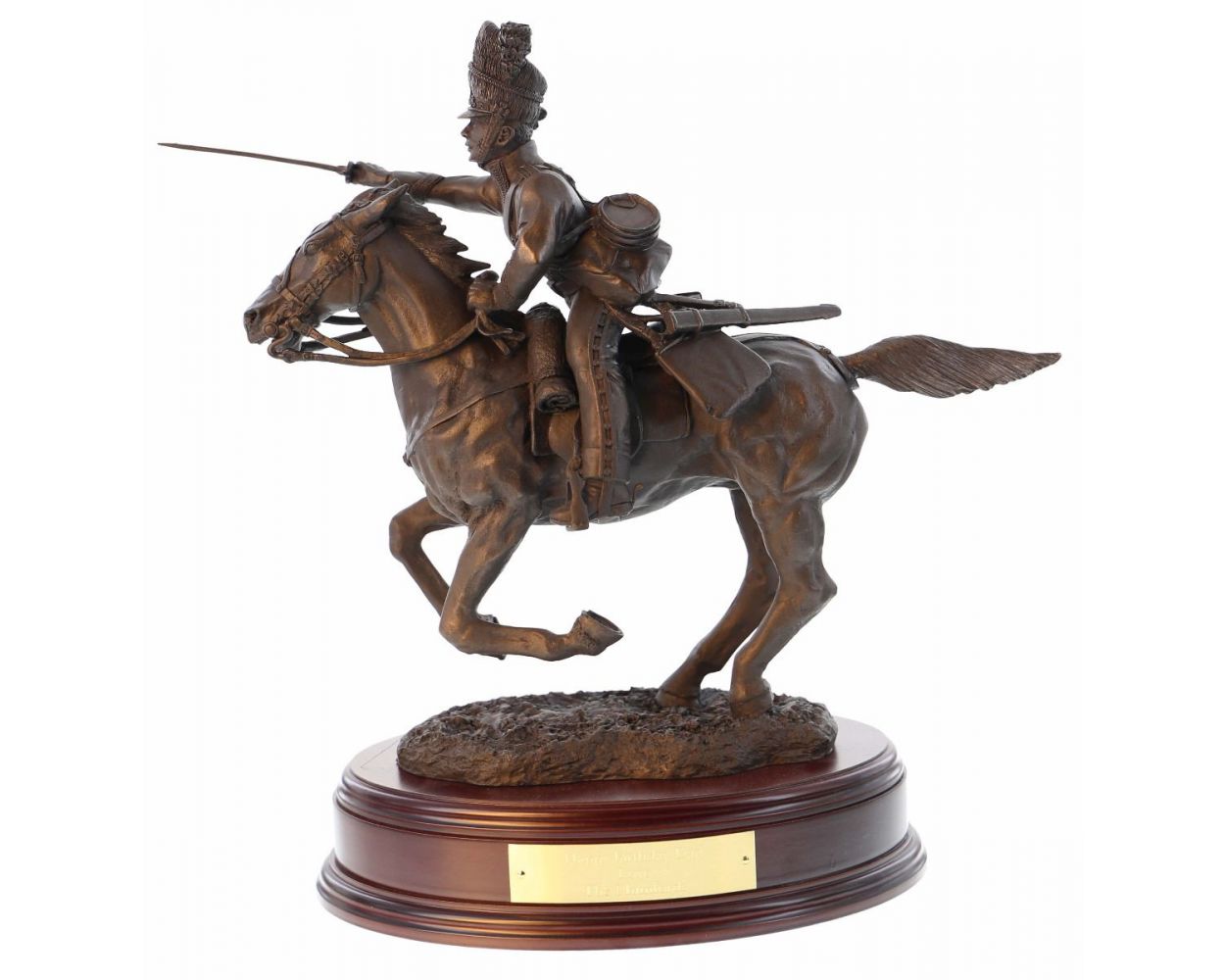Ballantynes Royal Scots Greys Charge at Waterloo, 1815, Bronze Statue
- Details
- More Information
- Reviews
- Brands
The figurine, made by Ballantynes of Walkerburn, depicts a trooper of the Royal Scots Greys at the height of the charge at the Battle of Waterloo, 1815. He wields the standard issue, straight cavalry sabre and carries a cavalry carbine against his saddle. We have displayed the figurine with his bearskin uncovered, however, following the heavy rains of the previous night, the regiment went into battle with their headgear covered.
THE SCOTS GREYS
UNION BRIGADE CHARGE
WATERLOO, 1815
On the 1st of March 1815, Napoleon Bonaparte landed in the south of France to reclaim his Empire. His leisurely march north to Paris became a triumphal procession as the people of France flocked to his standard. Europe was again plunged into crisis and the Allied Army, dispersed across Belgium, had to be reformed and rushed into new marshalling areas. It was imperative that the British and Prussian armies were combined prior to an engagement as united they out-numbered and out-gunned the French, but alone, each could easily be destroyed.
Napoleon seized the initiative and marched on Brussels in an attempt to split the Allies. On the 16th of June, the French met the British at Quatre Bras and the Prussians at Ligny. By nightfall both the allied armies were withdrawing, the Duke of Wellington to a good ridgeline position he favoured near the village of Waterloo.
The next morning the French army dithered whilst Napoleon decided on his options. He divided his force, despatching Marshall Grouchy after the Prussians, whilst he chased after the British. By nightfall, Napoleon's force had started to muster to the South of the British reverse slope position. Napoleon had by now realised the urgent need to, reunite his force, and drive home his attack on Wellington. In the night it poured with rain and at the dawn on 18th June ‘Le Grand Armee’ prepared for the attack. At 11 am following the grand parade, Napoleon ordered a diversionary attack on the British right flank at Hougomont Farm to draw Wellington’s reserves. At 1 p.m. Napoleon ordered his massive I Corps forward towards the British centre left. The huge force drove back the thin line of Dutch troops on the crest line and started to establish themselves on the key ground.
The Earl of Uxbridge, the British Cavalry commander, with his two Cavalry Brigades were ordered forward from the reserve by Wellington. These brigades were the finest Heavy Cavalry available to Wellington and their use this early in the battle indicated the urgency of the situation. Lord Ponsonby was in command of the Union Brigade on the left. As he reached the summit of the rise, precisely to his front, he saw the French, under considerable fire, debouching onto the track that runs along the crest. The Brigade immediately charged, with the Royals and Inniskillings to the front, and The Royal Scots Greys in support.
The Greys galloped headlong into two regimental columns of French infantry, the first were scattered and fled to the rear. The Second, the 45th ‘Invincibles’, was made of sterner stuff and offered a courageous defence. During spirited hand-to-hand fighting Sergeant Ewart of the Greys drove through the French defence and seized the Eagle standard of the 45th, which is on display to this day at the Regimental Museum in Edinburgh Castle. Gradually the cavalry overwhelmed I Corps and the French infantry halted and then began to retire. Within 20 minutes this had turned into a retreat with the Corps streaming back off the hill towards the French artillery line.
Elements of the Greys, in their excitement, pushed further, reaching the French artillery line, and they began to attack the hapless gunners. The charge had by now reached the stage on numerous isolated clumps of blown cavalrymen either fighting hand to hand with newly arriving French Dragoons or in retreat. In bloody hand-to-hand fighting, many of the Greys were now killed or wounded before they could reach the sanctuary of their own lines.
Forty per cent of the charging cavalry had fallen and the Royal Scots Greys suffered two hundred men and 224 horses killed or wounded. After the battle Napoleon referred to “les terribles chevaux gris” and Ewart was commissioned by the Prince Regent.


STAY CONNECTED